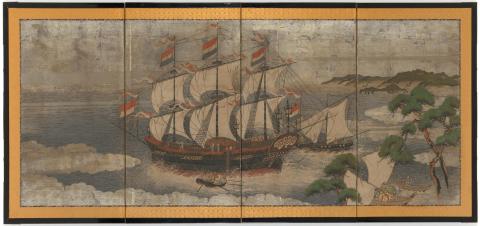Four-fold screen: Trading ship of the Dutch East India Company in Nagasaki Bay
By Tarun Nagesh
Artlines | 2-2021 | June 2021
Once a vital hub of international trade, the island of Dejima, its European ships and sailors were a subject of fascination for local artists, as depicted in this historical acquisition recently secured for the Collection through the generosity of the Henry and Amanda Bartlett Trust.
This Meiji-era (1868–1912) screen captures a large Dutch East India Company trading ship as traders and sailors begin disembarking onto their long boats, and Japanese cargo boats haul goods towards the Nagasaki shoreline. The painting provides a vivid historical scene, with the dominating ship tightly framed amid lapping waves and a silver-leaf skyline and clouds. A hive of activity, the subject draws attention to the complex history of trade and foreign encounters in Japan, and to the fascinating ways in which images of foreigners have been recounted in Japanese art.
The tiny artificial island of Dejima in the bay of Nagasaki — built by Portuguese traders who dug a canal through a peninsula — was the sole trading post for the Dutch in Japan for over two hundred years (1641–1859), where a handful of Dutch VOC (Vereenigde Oostindische Compagnie, or United East India Company, commonly referred to as the Dutch East India Company) employees would be stationed at any one time. This was one of the only points of contact for foreigners during Japan’s restrictive Edo period (1603–1867). Under heavy regulations and confined to this small island, these few VOC officers had a virtual monopoly on European trade with Japan, with China one of the few other trade channels that remained open.
Dutch trading ships docked at Dejima more than 600 times during this period, bringing Dutch delicacies as well as textiles, spices and raw materials from the VOC’s extensive trading outposts. Japanese porcelain became one of the most popular exports for the Dutch, fueling the growing demand for porcelain in Europe — some of the most well-known porcelain centres in Japan, such as Arita, were located near Nagasaki.1
As porcelain prices rose and Dutch trade with Japan became more difficult, the VOC brought an end to its trading partnership in 1799. The Dutch government then took over operations and responsibilities at Dejima, maintaining it as a trading post until the end of the Edo period, when the port opened more liberally to Western trade. The Dutch the continued as free merchants, though now in competition with a host of other foreigners. The island was returned to the Japanese in 1863.
This depiction gestures towards a celebrated earlier painting tradition known as Nanban-ga (Nanban meaning ‘southern barbarians’). Nanban-ga was produced in the sixteenth and seventeenth centuries and depicted European traders and missionaries, before the isolationist policies of the Edo period were introduced around 1614. The most treasured examples are those painted on the broad horizontal plane of screens and commonly depict European ships arriving in the trading ports.
While this work echoes the original Nanban genre, it was executed later during the Meiji period, when Japan had reopened its borders and, after a long absence, foreigners — and particularly American and European ships — were becoming a more accessible subject and a curiosity for artists, including the late ukiyo-e woodblock printmakers.
Tarun Nagesh is Curatorial Manager, Asian and Pacific Art.
Endnote
- Marani Arts and Antiques [catalogue entry], Victoria, 2020, sent to author 11 November 2020.
